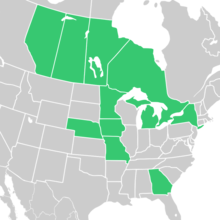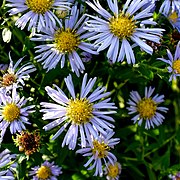Symphyotrichum firmum
| Symphyotrichum firmum | |
|---|---|

| |
| S. firmum, Ontario, Canada | |
| Scientific classification | |
| Kingdom: | Plantae |
| Clade: | Tracheophytes |
| Clade: | Angiosperms |
| Clade: | Eudicots |
| Clade: | Asterids |
| Order: | Asterales |
| Family: | Asteraceae |
| Tribe: | Astereae |
| Subtribe: | Symphyotrichinae |
| Genus: | Symphyotrichum |
| Subgenus: | Symphyotrichum subg. Symphyotrichum
|
| Section: | Symphyotrichum sect. Symphyotrichum
|
| Species: | S. firmum
|
| Binomial name | |
| Symphyotrichum firmum | |

| |
| Native distribution[2] | |
| Synonyms[2] | |
|
Basionym
Alphabetical list
| |
Symphyotrichum firmum (formerly Aster firmus), commonly known as shining aster, shiny-leaved aster,
Description
Symphyotrichum firmum is a
It flowers August through October. The
S. firmum has a
Compared to the closely related Symphyotrichum puniceum, S. firmum is less hairy overall, has denser inflorescences of smaller, whiter flowers, and grows in larger, denser patches.[4][6]
-
Symphyotrichum puniceum on left and S. firmum on right
-
Involucre showing phyllaries and bracts
-
Flower heads close-up
Taxonomy
Symphyotrichum firmum is closely related and morphologically very similar to Symphyotrichum puniceum (purple-stemmed aster), and is not always treated as a separate species. However, there is little evidence of intergrades between the two taxa, and most sources now treat them as distinct.[5][6]
Distribution and habitat
Its range is poorly known due to confusion with the closely related Symphyotrichum puniceum.[5] In Canada it has been recorded from Alberta to Quebec.[3] In the United States, it occurs in the Midwest, some parts of the Northeast, and in the Appalachian Mountains south to Georgia.[5][6][2] It is more common in the western part of its range.[6]
Symphyotrichum firmum grows in moist and sunny areas such as fens and wet prairies.[4][7] It is often found growing with S. puniceum.[6] Unlike S. puniceum, it sometimes spreads into drier areas.[4]
Ecology
Bees that have been observed visiting the flowers include the bicolored striped-sweat bee (
Conservation
As of December 2021[update], NatureServe listed Symphyotrichum firmum as Secure (G5) worldwide, Vulnerable (S3) in Quebec, and Presumed Extirpated (SX) in New Jersey.[1]
Notes
Citations
References
- Brouillet, L.; Desmet, P.; Coursol, F.; Meades, S.J.; Favreau, M.; Anions, M.; Bélisle, P.; Gendreau, C.; Shorthouse, D. (2019). "Symphyotrichum firmum (Nees) G.L. Nesom". data.canadensys.net. Database of Vascular Plants of Canada (VASCAN). Retrieved 7 January 2020.
- Brouillet, L.; Semple, J.C.; Allen, G.A.; Chambers, K.L.; Sundberg, S.D. (2006). "Symphyotrichum firmum". In Flora of North America Editorial Committee (ed.). Flora of North America North of Mexico (FNA). Vol. 20. New York and Oxford: Oxford University Press. Retrieved 5 July 2021 – via eFloras.org, Missouri Botanical Garden, St. Louis, MO & Harvard University Herbaria, Cambridge, MA.
- NatureServe (6 December 2021). "Symphyotrichum firmum - Swamp Aster". NatureServe Explorer (explorer.natureserve.org). NatureServe. Retrieved 12 December 2021.
- POWO (2019). "Symphyotrichum firmum (Nees) G.L.Nesom". Plants of the World Online (www.plantsoftheworldonline.org). Royal Botanic Gardens, Kew. Retrieved 4 July 2021.
- Reznicek, A.A.; Voss, E.G.; Walters, B.S., eds. (February 2011). "Symphyotrichum firmum". Michigan Flora Online. University of Michigan Herbarium. Retrieved 7 January 2020.
- Warners, D.P.; Laughlin, D.C. (1999). "Evidence for a species-level distinction of two co-occurring asters: Aster puniceus L. and Aster firmus Nees" (PDF). Great Lakes Botanist. 38 (2). Retrieved 8 January 2020.
- OCLC 983207050.




